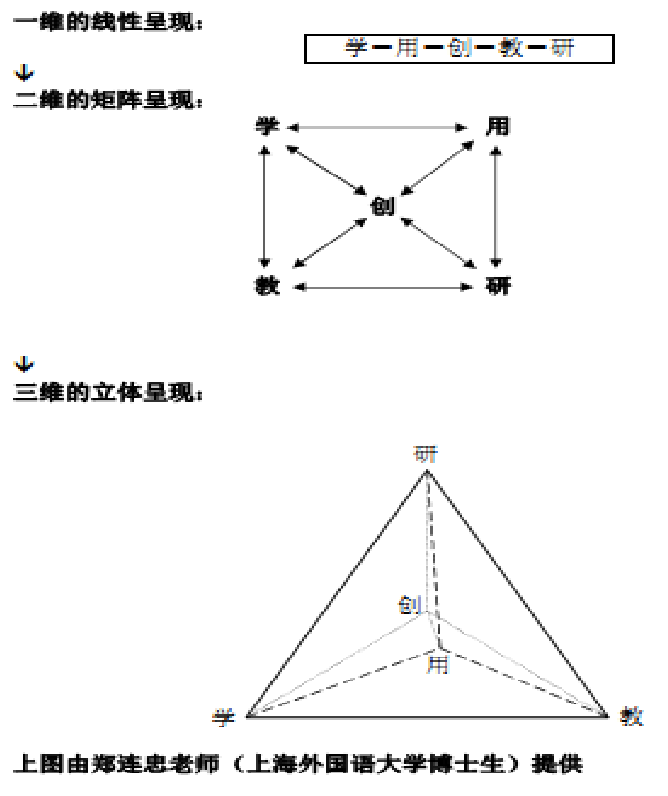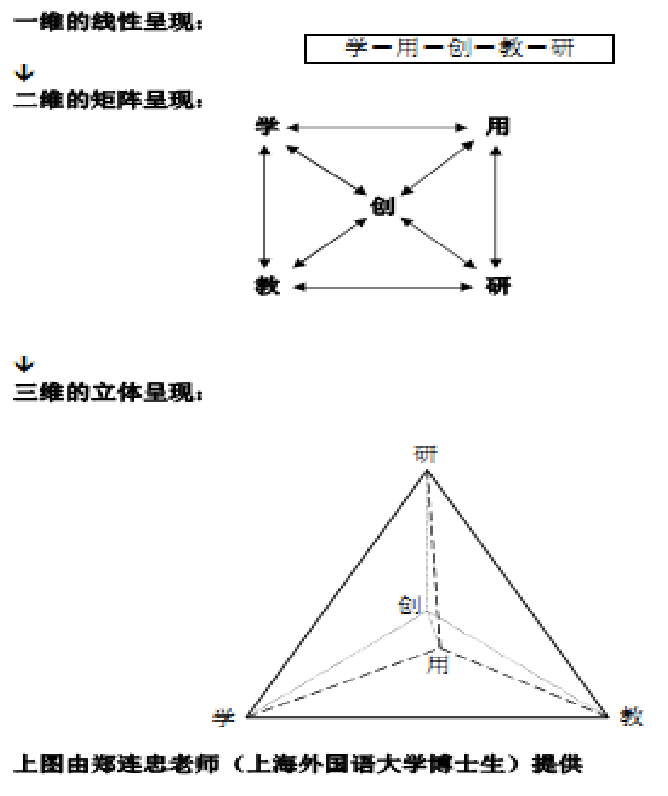2012年2月24日
February 24, 2012
求真大讲堂
浙师大外国语言文学一级学科论坛
Truth-Seeking Free Forum for Foreign Studies, ZJNU
语言与创造性思维
Language and Creative Thinking
吴本虎
Wu Benhu
1. Initial Considerations
People often ask questions but few of them consider what kind of questions is to be asked.
This can be a starting point for us to consider language and creative thinking as two related components in our mind:
What kind of questions shall we ask to develop our language skills and creative thinking skills at the same time?
We may prefer two kinds of questions:
1) Basic questions.
2) Challenging questions.
Now, just think of some basic questions and some challenging questions related to language and creative thinking:
1) Some basic questions:
(1) What is language?
(2) What is thinking?
(3) What is creative thinking?
2) Some challenging questions:
(1) What is the interplay between language and thinking?
(2) What is the interaction between language use and creative thinking?
(3) How can we transform our thinking into creative thinking?
2. Basic Questions Revisited
2.1 What Is Language?
Language is a system of arbitrary vocal symbols used for human communication (Dai et al., 2010: 7).
Language is the system of human communication which consists of the structured arrangement of sounds (or their written representation) into larger units, e.g. morphemes, words, sentences, utterances (Richards and Schmidt, 2010: 311).
To give the barest of definition, language is a means of verbal communication (Hu et al., 2011: 3).
From the above definitions, we can discover that language is widely viewed as a system or means of communication. Those definitions fails to highlight the most important human mechanism ‘cognition’. With this limitation taken into consideration, I would propose an updated definition of language:
Wu Benhu’s Definition of Language:
Language is human cognitive power enabling human beings to explore the ever-developing world that is becoming more and more complicated and thus requires more communication and collaboration for the creation of a better world.
吴本虎对语言的定义:
语言是人类用以探索不断变化且变得越来越复杂因而愈加需要通过交流与合作来创造一个更美好世界的认知力。
以上定义的出现意味着对语言的认识经历了从“系统观”到“交际观”,再到目前的“认知观”的发展变化。
这一认识宣示了这样一种觉醒意识:对语言的认识不应长期停留在“语言是交际工具”上。
我们的国家社科基金项目“以发展综合认知能力为目标的英语教学研究”正是基于这样一种对语言的基本认识上的觉醒意识:
语言是认知的源泉。
语言不仅是交际工具,而且是认识世界、改造世界和创造世界的力量。它是人类生产力和创造力的基础。
语言始终在人类认识世界、改造世界和创造世界的过程中发展与丰富本身。
所以,英语教学的目标不能长期局限于“培养交际能力”,而应当将“发展包括语言能力、思维能力、感知能力、记忆能力等在内的综合认知能力”作为新的目标。--吴本虎
2.2 What Is Thinking?
I did not know how to define ‘thinking’ and searched the Internet for this concept. The following is my search for definitions of thinking:
http://www.google.com.hk/ > thinking is
\/
[PDF] Mind Your Mind
www.recoveryxchange.org/downloads/Mind%20Power.pdf -
The Power of Repeated Words and Thoughts. Thinking is usually a mixture of words, sentences, mental images and sensations. Thoughts are visitors, who visit ...
\/
http://www.recoveryxchange.org/downloads/Mind%20Power.pdf
\/
Mind Your Mind: Articles about Mind Power
by Remez Sasson
Page 28
The Power of Repeated Words and Thoughts
Thinking is usually a mixture of words, sentences, mental images and sensations. Thoughts are visitors, who visit the central station of the mind. They come, stay a while, and then disappear, making space for other thoughts. Some of these thoughts stay longer, gain power, and affect the life of the person thinking them (Sasson, 2007).
\/
From the above, we can see that thinking is a human mechanism that involves not only thinking competence, but also language competence, perception competence and memory competence.
2.3 What Is Creative Thinking?
I further searched the Internet for the concept of ‘creative thinking’ and got the following:
Creativity and Creative Thinking
http://www.brainstorming.co.uk/tutorials/creativethinking.html
\/
What is creative thinking?
Creative thinking is the process which we use when we come up with a new idea. It is the merging of ideas which have not been merged before. Brainstorming is one form of creative thinking: it works by merging someone else's ideas with your own to create a new one. You are using the ideas of others as a stimulus for your own.
I might present numerous definitions and accounts of creative thinking. But I would rather add my account of creative thinking from the perspective of problem solving:
Wu Benhu’s Account of Creative Thinking
Creative thinking is the combination of divergent thinking and convergent thinking in the process of problem solving:
We use divergent thinking to find out solutions to a problem as many as possible.
We use convergent thinking to select the most appropriate solution among those identified

3. Some Challenging Questions Explored
3.1 What Is the Interplay Between Language and Thinking?
If we accept the view of language as human cognitive power and the view of thinking as a mixture of words, sentences, mental images and sensations, the interplay between language and thinking can be viewed as one within our extended cognitive mechanism including both language and thinking and we would further assume the foundation of this extended cognitive mechanism is the integrated cognitive competence with language competence, thinking competence, perception competence and memory competence as its major components.
The Interplay between language and thinking can thus be considered in the framework of the integrated cognitive competence because in reality and from the perspective of the operational process of human mental mechanism, language and thinking rely on each other. Language is to be substantialized with thinking while thinking is to be crystallized in language. Otherwise, the former would be a pile of dead words while the latter could not be transmitted and perceived by others.
3.2 What Is the Interaction Between Language Use and Creative Thinking?
With the assumption that Language is to be substantialized with thinking while thinking is to be crystallized in language, the interaction between language use and creative thinking is expected to be considered in terms of how language is used and how thinking is performed.
In order to demonstrate the interaction between language use and creative thinking, we need to visualize the relationship between language and creative thinking as follows:
|
Component |
Creative thinking |
Creative language use |
|
Defining feature |
Conceptual creativity |
Linguistic productivity |
|
Approach |
Conceptual operation |
Word arrangement |
|
Augmentation |
Conceptual expansion |
Word addition |
|
Transposition |
Conceptual transformation |
Word inversion |
|
Progression |
Conceptual intensification |
Lexical elevation |
|
Dimensional shift |
Conceptual reorganization |
Word reposition |
|
…… |
…… |
…… |
Table 1 Relating creative thinking with creative language use
From Table 1, we conceive that creative thinking has conceptual creativity as its defining feature while creative language use has linguistic productivity as its defining feature. Their realization can be conceived as conceptual operation and word arrangement respectively. Their realization mechanisms can be specified as augmentation, transposition, dimensional shift, and so on. We further conceive the correspondence between creative thinking and creative language use as pairings of conceptual expansion and word addition in augmentation, conceptual transformation and word inversion in transposition, conceptual intensification and lexical elevation in progression and conceptual reorganization and word reposition in dimensional shift with the former being conceptual operation and the latter word arrangement. This listing can be lengthened as more and more pairings of conceptual operation and word arrangement are added.
3.3 How Can We Transform Our Thinking into Creative Thinking?
With the conceptualization presented above, we can progressively conceive the transformational process from thinking to creative thinking with the terminology given. The following are some examples:
Sample 1 A case of augmentation followed by dimensional shift
2010年2月7日星期日原创(2012年2月26日更新)
对外语教师发展的新思考
――从“教学相长”到“‘学-用-创-研-教’五驾齐驱”
学无止境
Ü
教学相长
Ü
“教-学-研”一体化
Ü
“学-用-研-教”四位一体
Ü
“学-用-创-教-研”五驾齐驱
Ü

Figure 3 Step-by-Step Construction of the Model of Teacher Development
From Sample 1, we can see that an augmentation has been achieved by conceptual expansion and word addition step by step from 学无止境 to 教学相长, next to “教-学-研”一体化, then to “学-用-研-教”四位一体, and as the latest step to “学-用-创-教-研”五驾齐驱. A progression is realized from one-dimension presentation through two-dimension presentation to three-dimension presentation.
Sample 2 A Case of transposition and progression
2007年3月15日星期四 01:16-02:17
关于思考的思考
----从“民族的思考”到“思考的民族”
只有敢于思考,才有可能超越过去,自拔自救。
只有勤于思考,才有可能超越他人,自立自强。
只有善于思考,才有可能超越自己,自新自为。
Thinking about Thinking
--From “A Nation’s Thinking” to “A Thinking Nation”
Only a nation that takes initiatives in independent thinking can stop the indulgence of its past pride to achieve self-salvation.
Only a nation that maintains diligence in critical thinking can regain a lead in its lasting self-strengthening.
Only a nation that resorts to creative thinking can break the barrier of its own limited capacity to realize self-transcendence.
From Sample 2, we can see a transposition is achieved from 民族的思考 to 思考的民族 which and be interpreted as conceptual transformation and word inversion at the same time. A progression is realized from 敢于 through 勤于 to 善于 and another progression is embedded in 自拔自救, 自立自强, 自新自为.
Sample 3 A case of progression and augmentation
在浙师大外语系87级毕业二十周年同学会之际
寄语曾为学习而有幸相逢、相处、相知的朋友们:
共同学习成挚友
经历,对于每一个人来说都是宝贵而难忘的。
共同的经历,对于每一个有缘在一起的朋友来说显得更为珍贵与久久难忘。
共同的学习经历,对于每一个有幸在一道的学友来说则甚于金贵,让大家感受到她在无时不刻地灿灿发亮,使我们在低迷之际满怀信心负重承担,在危难之中鼓足勇气力挽狂澜,在胜利之时迎着未来启程扬帆。
让我们在交流中延续共同学习的经历,愿大家在分享中升华共同学习的经历,携手续写一曲由朋友变为学友进而成为挚友的壮丽诗篇。
吴本虎写于杭州至金华的火车上
2011年10月4日晚
From Sample 3, we can see that a progression is achieved from 相逢 through 相处 to 相知. Another progression is realized in the sequential use of 朋友, 学友 and 挚友. The augmentation can be seen from 经历 through 共同的经历 to 共同的学习经历.
References
Dai, Weidong, et al. 2010. A New Concise Course on Linguistics for Students of English (2nd edition). Shanghai: Shanghai Foreign Language Education Press.
Hu, Zhuanglin, et al. 2011. Linguistics: A Course Book. (4th edition). Beijing: Peking University Press.
Infinite Innovations. 2011. Creativity and Creative Thinking. http://www.brainstorming.co.uk/tutorials/creativethinking.html (accessed 24/02/2012).
Richards, J. C., J. Platt and H. Platt. 2010. Longman Dictionary of Language Teaching and Applied Linguistics (4th edition). Harlow: Longman.
Sasson, Remez. 2007. Mind Your Mind: Articles about Mind Power. Retrieved http://www.recoveryxchange.org/downloads/Mind%20Power.pdf (accessed 24/02/2012).